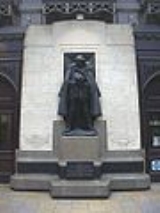
Great Western Railway War Memorial
Encyclopedia
The Great Western Railway War Memorial is a monument in London
, United Kingdom
, to the employees of the Great Western Railway
who died during the First World War, and it is situated half-way along platform 1 at London Paddington station. The stonework was designed by the architect Thomas S. Tait
and the bronze figure by the sculptor Charles Sargeant Jagger
, and the memorial unveiled on Armistice Day
in 1922 by Viscount Churchill
.
Its dominant feature is a large bronze statue of a British First World War soldier dressed in battle gear, wearing a helmet, woolen scarf, and a greatcoat draped over his shoulders. The soldier is looking down, reading a letter from home.
On the stone surround are two stylised reliefs of the emblems of the Royal Navy (rope and anchor) and the Royal Air Force (eagle in flight). Inside the plinth was placed a sealed casket, which was made at the GWR's Swindon Works
, containing a vellum roll upon which was inscribed the names of the 2,524 men who gave their lives.
Inside the waiting room behind the memorial is a plaque marking the unveiling of the memorial, which includes the inscription:
London
London is the capital city of :England and the :United Kingdom, the largest metropolitan area in the United Kingdom, and the largest urban zone in the European Union by most measures. Located on the River Thames, London has been a major settlement for two millennia, its history going back to its...
, United Kingdom
United Kingdom
The United Kingdom of Great Britain and Northern IrelandIn the United Kingdom and Dependencies, other languages have been officially recognised as legitimate autochthonous languages under the European Charter for Regional or Minority Languages...
, to the employees of the Great Western Railway
Great Western Railway
The Great Western Railway was a British railway company that linked London with the south-west and west of England and most of Wales. It was founded in 1833, received its enabling Act of Parliament in 1835 and ran its first trains in 1838...
who died during the First World War, and it is situated half-way along platform 1 at London Paddington station. The stonework was designed by the architect Thomas S. Tait
Thomas S. Tait
Thomas Smith Tait was a prominent Scottish Modernist architect. He designed a number of buildings around the world in Art Deco and Streamline Moderne styles, notably St...
and the bronze figure by the sculptor Charles Sargeant Jagger
Charles Sargeant Jagger
Charles Sargeant Jagger MC was a British sculptor who, following active service in the First World War, sculpted many works on the theme of war...
, and the memorial unveiled on Armistice Day
Armistice Day
Armistice Day is on 11 November and commemorates the armistice signed between the Allies of World War I and Germany at Compiègne, France, for the cessation of hostilities on the Western Front of World War I, which took effect at eleven o'clock in the morning—the "eleventh hour of the eleventh day...
in 1922 by Viscount Churchill
Victor Spencer, 1st Viscount Churchill
Major Victor Albert Francis Charles Spencer, 1st Viscount Churchill GCVO JP , known as The Lord Churchill between 1886 and 1902, was a British peer and courtier....
.
Its dominant feature is a large bronze statue of a British First World War soldier dressed in battle gear, wearing a helmet, woolen scarf, and a greatcoat draped over his shoulders. The soldier is looking down, reading a letter from home.
On the stone surround are two stylised reliefs of the emblems of the Royal Navy (rope and anchor) and the Royal Air Force (eagle in flight). Inside the plinth was placed a sealed casket, which was made at the GWR's Swindon Works
Swindon Works
Swindon railway works were built by the Great Western Railway in 1841 in Swindon in the English county of Wiltshire.-History:In 1835 Parliament approved the construction of a railway between London and Bristol. Its Chief Engineer was Isambard Kingdom Brunel.From 1836, Brunel had been buying...
, containing a vellum roll upon which was inscribed the names of the 2,524 men who gave their lives.
Inscriptions
The Inscriptions on the plinth read:IN HONOUR OF THOSE WHO SERVED IN THE WORLD WARS
1914 † 1918 1939 † 1945
3312 MEN AND WOMEN OF THE GREAT WESTERN RAILWAY GAVE THEIR LIVES FOR KING AND COUNTRY. THE NAMES OF THOSE WHO GAVE THEIR LIVES ARE INSCRIBED ON A ROLL OF HONOUR DEPOSITED BENEATH THE BRONZE FIGURE. ||
Inside the waiting room behind the memorial is a plaque marking the unveiling of the memorial, which includes the inscription:
THE GREAT WESTERN RAILWAY WAR MEMORIAL
ON PLATFORM No 1 IMMEDIATELY OUTSIDE THIS ROOM WAS UNVEILED ON ARMISTICE DAY, SATURDAY, NOVEMBER 11TH 1922
BY THE RT. HON VISCOUNT CHURCHILL, G.C.V.Q. AND DEDICATED BY HIS GRACE THE ARCHBISHOP OF CANTERBURY.
THE BRONZE FIGURE WAS EXECUTED BY MR. C.S. JAGGER, M.C., R.B.S. AND THE ARCHITECTURAL WORK BY MR. T.S.TAIT A.R.I.B.A.
||
External links
- Conservation of the Paddington War Memorial - Rupert Harris Conservation
- History of Paddington Station- Crossrail
- War memorial, Paddington Station - English Heritage
- War memorial Paddington Station - Geograph
- Great Western Railway War Memorial - York University Institute of Railway Studies and Transport History

